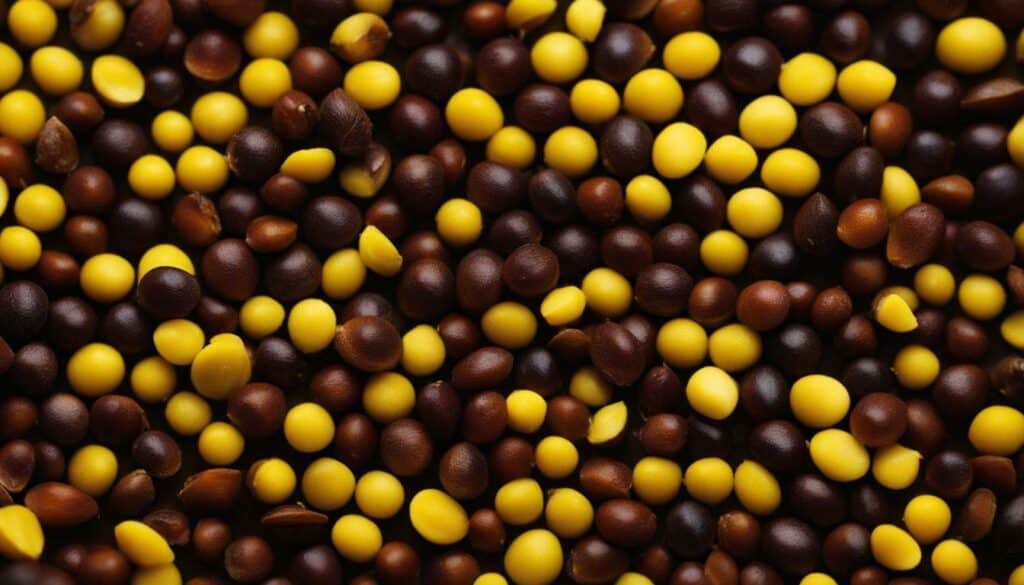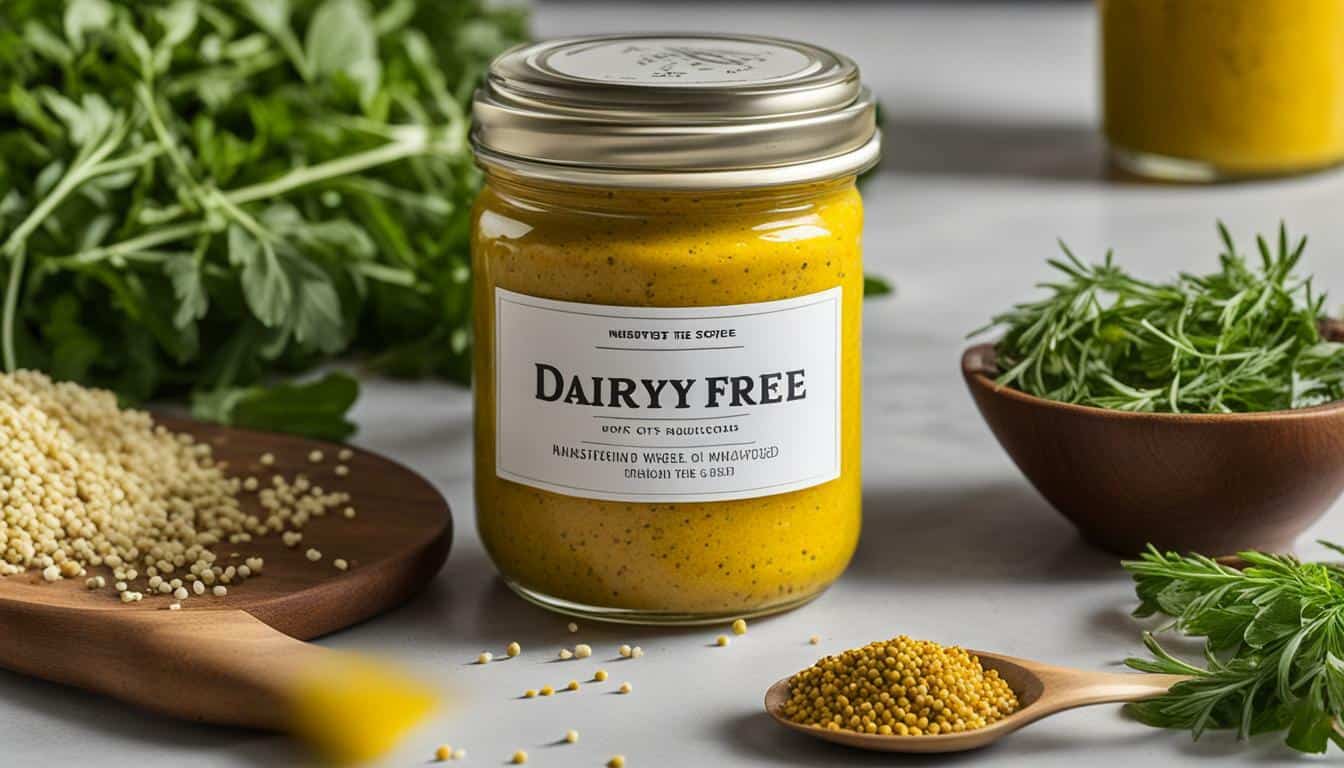If you’re unsure whether mustard contains dairy or not, let me put all your doubts to rest. Mustard, derived from the seeds of the mustard plant, does not contain any dairy ingredients. It is a condiment traditionally made by grinding mustard seeds and mixing them with water, vinegar, or other liquids to create that tangy flavor we all love. So, if you have a milk allergy, you can enjoy mustard without worry.
- Mustard does not contain dairy and is safe for individuals with a milk allergy.
- Mustard is made from mustard seeds and mixed with water, vinegar, or other liquids.
- Mustard allergy is considered a serious issue and is included on Canada’s list of top food allergens.
- Mustard can be found in various foods and dishes, so individuals with mustard allergies should check ingredient labels.
- Cross-reactivity with other seeds is possible for individuals with mustard allergy.
Understanding Mustard Ingredients
Mustard is made by grinding mustard seeds and combining them with water, vinegar, or other liquids, which means it doesn’t contain any dairy ingredients. The process of making mustard involves extracting the natural oils and flavors from the seeds, resulting in a tangy and pungent condiment that is enjoyed worldwide. The absence of dairy ingredients in mustard makes it a suitable choice for individuals with lactose intolerance or milk allergies.
Mustard plants are commonly grown in temperate regions and have been used for culinary and medicinal purposes for centuries. The seeds themselves are small and round, and they come in different colors, including yellow, brown, and black. These seeds are what give mustard its characteristic taste and aroma.
When making mustard, the seeds are ground into a fine powder and then combined with liquid ingredients, such as water or vinegar, to create a paste. Other flavorings, such as salt, sugar, and spices, may also be added to enhance the taste. The mixture is then left to sit and develop its flavors before being bottled and sold as mustard.
It’s important to note that while mustard itself doesn’t contain any dairy, it can still be found in various prepared foods and cooked dishes. It is commonly used as a condiment for hot dogs, sandwiches, and burgers, but it can also be found in salad dressings, pickles, soups, sausages, and marinades. For individuals with mustard allergies, it is crucial to read ingredient labels carefully and avoid all forms of mustard, as even processed and heated variations can cause a reaction.
| Mustard Varieties | Color | Flavor Profile |
|---|---|---|
| Yellow Mustard | Yellow | Mild and tangy |
| Dijon Mustard | Yellow or brown | Sharp and spicy |
| Spicy Brown Mustard | Brown | Robust and fiery |
| Whole Grain Mustard | Variety of colors | Textured and tangy |
In conclusion, mustard is a versatile condiment made by grinding mustard seeds and mixing them with water, vinegar, or other liquids. It does not contain any dairy ingredients, making it safe for individuals with milk allergies or lactose intolerance. However, it is important for those with mustard allergies to be cautious of its presence in various foods and dishes. By diligently reading ingredient labels and avoiding all forms of mustard, individuals can manage their allergy effectively and enjoy a wide range of culinary options.

Good news for people with dairy allergies – mustard poses no threat in terms of lactose or milk protein content. Mustard is a condiment made from grinding mustard seeds and mixing them with water, vinegar, or other liquids. It is widely used in various foods and cooked dishes, including salad dressings, pickles, soups, sausages, and marinades. Despite its prevalence, mustard does not contain any dairy components, making it a safe option for individuals with milk allergies.
Mustard allergy is a serious issue for some individuals, and it is important to be aware of its potential symptoms and risks. Common symptoms of mustard allergy include abdominal pain, hives, wheezing, and in severe cases, anaphylaxis. To manage mustard allergies, individuals must carefully read ingredient labels and avoid all forms of mustard. It’s worth noting that even processed and heated forms of mustard can cause a reaction.
Cross-reactivity with other seeds is possible for individuals with mustard allergies. If you have a mustard allergy, it is recommended to consult with a healthcare professional to determine specific allergens and potential cross-reactions. Additionally, for patients with an IgE-mediated food allergy, especially those with poorly controlled asthma, having an epinephrine prescription is highly recommended to be prepared in case of severe allergic reactions.
Mustard Allergy: A Serious Concern
While mustard doesn’t contain dairy, it is important to be aware of the risks associated with mustard allergies. Mustard allergy is considered a serious issue, and it is among the top food allergens in Canada. For those with a mustard allergy, consuming even small amounts of mustard or its derivatives can trigger a range of symptoms, from abdominal pain and hives to wheezing and anaphylaxis.
Mustard can be found in various foods and cooked dishes, making it crucial for individuals with mustard allergies to carefully read ingredient labels. Common foods that may contain mustard include salad dressings, pickles, soups, sausages, and marinades. Even processed and heated forms of mustard can cause an allergic reaction, so it’s important to avoid all forms of mustard if you have a mustard allergy.
The severity of mustard allergies highlights the need for caution when consuming foods that may contain mustard. It’s always better to be safe than sorry, so checking ingredient labels and avoiding any form of mustard is key for individuals with a mustard allergy.
It’s worth noting that individuals with a mustard allergy may also experience cross-reactivity with other seeds. Mustard belongs to the Brassicaceae plant family, which includes other seeds like rapeseed, turnip, cabbage, and cauliflower. If you have a mustard allergy, it’s essential to consult with a healthcare professional to determine any specific allergens that may cause cross-reactivity.
For those with an IgE-mediated food allergy, especially individuals with poorly controlled asthma, it is recommended to have an epinephrine prescription. Epinephrine is a fast-acting medication that can help manage severe allergic reactions in emergency situations. Always be prepared and have an epinephrine auto-injector on hand, especially if you have a known mustard allergy.
| Key Points: |
|---|
| Mustard contains no dairy, but mustard allergies can be severe. |
| Mustard can be found in various foods, so reading ingredient labels is crucial. |
| Individuals with a mustard allergy may experience cross-reactivity with other seeds. |
| An epinephrine prescription is recommended for those with an IgE-mediated food allergy and poorly controlled asthma. |
Mustard in Various Foods
Mustard can be found in numerous food items and cooked dishes, making it essential to be vigilant for those with mustard allergies. This versatile condiment adds a tangy and zesty flavor to a wide range of culinary creations. Whether it’s a classic hot dog with mustard or a creamy mustard dressing on a fresh salad, this condiment is a staple in many kitchens.

One popular use of mustard is in salad dressings. It adds a bold and tangy element to both vinaigrettes and creamy dressings, elevating the taste profile of a simple salad. Mustard can also be found in pickles, providing a burst of flavor and enhancing the overall brine. It brings a unique taste to soups, adding depth and complexity to the broth.
In savory dishes, mustard is often used as a marinade or a key ingredient in sauces. It can be found in sausages, adding a hint of spice and enhancing the richness of the meat. Mustard is also commonly used in marinades for grilled meats, allowing the flavors to penetrate deep into the protein.
| Common Foods with Mustard | Mustard Varieties |
|---|---|
| Hot dogs and sandwiches | Dijon mustard |
| Burgers and sausages | Yellow mustard |
| Potato salad and coleslaw | Whole grain mustard |
| Pickle relish and salad dressings | Spicy brown mustard |
It’s important for individuals with mustard allergies to carefully check ingredient labels to avoid any potential risks. Even processed and heated forms of mustard can still trigger an allergic reaction. By being aware of the presence of mustard in various foods, those with allergies can take necessary precautions and ensure their safety.
Managing Mustard Allergies
If you have a mustard allergy, it’s crucial to carefully read ingredient labels and steer clear of any form of mustard, even when it is processed or heated. Mustard allergy is considered a serious concern, and even small amounts of mustard can cause symptoms such as abdominal pain, hives, wheezing, and in severe cases, anaphylaxis. It’s important to be vigilant about avoiding mustard to prevent any potential risks or reactions.
Mustard can be found in a variety of foods and cooked dishes, so it’s essential to be aware of its presence. Common foods that may contain mustard include salad dressings, pickles, soups, sausages, and marinades. Always remember to check ingredient labels carefully, as even trace amounts of mustard or mustard derivatives can be hidden in processed or packaged foods.
In addition to mustard, individuals with mustard allergies may experience cross-reactivity with other seeds. This means that if you have a mustard allergy, you might also experience allergic reactions to other seeds like poppy, sesame, or sunflower seeds. It’s best to consult with a healthcare professional to determine any specific allergens and to get personalized advice on managing your allergy.

If you have an IgE-mediated food allergy, particularly if you have poorly controlled asthma, it is recommended to have an epinephrine prescription. Epinephrine is a medication that can be used to treat severe allergic reactions, including anaphylaxis. It’s important to be prepared and have access to this life-saving medication in case of a severe allergic reaction to mustard or any other allergens.
Summary:
- Mustard allergy is a serious concern and can cause various symptoms, including abdominal pain, hives, wheezing, and anaphylaxis.
- It’s crucial for individuals with mustard allergies to carefully read ingredient labels and avoid all forms of mustard, even when processed or heated.
- Mustard can be found in a variety of foods and cooked dishes, so it’s important to be diligent in checking for its presence.
- Cross-reactivity with other seeds is possible for individuals with mustard allergies, so consulting with a healthcare professional is advisable.
- For those with an IgE-mediated food allergy, having an epinephrine prescription is recommended, especially if asthma is poorly controlled.
By taking these precautions and staying informed, individuals with mustard allergies can manage their condition effectively and reduce the risk of allergic reactions.
Cross-Reactivity with Other Seeds
People with mustard allergies may experience cross-reactivity with other seeds, so it’s advisable to seek medical advice for further clarification. Cross-reactivity occurs when the proteins in one food are similar to those in another, leading to an allergic reaction in individuals with specific allergies.
One common example of cross-reactivity with mustard allergy is with other members of the Brassicaceae family, such as broccoli, cauliflower, and cabbage. These vegetables contain similar proteins that can trigger an allergic response in some people allergic to mustard.
Another seed that may cross-react with mustard is the sesame seed. While sesame seeds are not part of the Brassicaceae family, they have been shown to share allergenic proteins with mustard. Therefore, individuals with mustard allergies should be cautious when consuming products that contain sesame seeds, such as tahini or sesame oil.
Table: Seeds that may cross-react with mustard
| Seed | Common Foods |
|---|---|
| Broccoli | Broccoli soup, stir-fried broccoli |
| Cauliflower | Cauliflower rice, roasted cauliflower |
| Cabbage | Coleslaw, cabbage rolls |
| Sesame | Tahini, sesame oil |
Cross-reactivity can vary from person to person, and not all individuals with mustard allergies will experience a reaction to these other seeds. However, it’s essential to be aware of this possibility and take necessary precautions.

In conclusion, individuals with mustard allergies should be mindful of possible cross-reactivity with other seeds. Consulting with a healthcare professional is crucial to understand personal allergenic triggers and to receive appropriate guidance. By staying informed and cautious, individuals with mustard allergies can manage their condition and avoid potential allergic reactions.
Epinephrine for Mustard Allergy
For individuals with an IgE-mediated food allergy, especially those with poorly controlled asthma, having an epinephrine prescription is highly recommended. Mustard allergy is considered a serious issue in certain countries and can lead to severe allergic reactions, including anaphylaxis. Epinephrine, also known as adrenaline, is a life-saving medication that can be administered in case of a severe allergic reaction.
Mustard allergy symptoms can range from mild to severe and may include abdominal pain, hives, wheezing, difficulty breathing, and swelling of the face, lips, tongue, or throat. In some cases, a mustard allergy can cause anaphylaxis, a potentially life-threatening reaction that requires immediate medical attention. Epinephrine works by constricting blood vessels, opening up airways, and reversing the symptoms of an allergic reaction.
It is essential for individuals with a mustard allergy to carry an epinephrine auto-injector at all times and know how to use it effectively. The auto-injector should be easily accessible in case of an emergency. After administering epinephrine, it is crucial to seek immediate medical attention, as further treatment may be required. Remember to check the expiration date on your epinephrine device regularly and replace it when necessary.
In addition to carrying an epinephrine auto-injector, individuals with a mustard allergy should take precautions to avoid exposure to mustard and products containing mustard. This includes carefully reading ingredient labels, asking about the presence of mustard in restaurants and food establishments, and being cautious when consuming foods that may contain hidden sources of mustard.
Consulting with a healthcare professional, such as an allergist or immunologist, can provide further guidance and personalized recommendations for managing a mustard allergy. They can help identify potential cross-reactivity with other seeds and advise on specific allergen avoidance strategies. By staying vigilant and prepared, individuals with a mustard allergy can reduce the risk of an allergic reaction and maintain a safe and healthy lifestyle.
Conclusion
In conclusion, mustard is a dairy-free condiment, making it a safe choice for individuals with milk allergies. Mustard plants are herbs grown in temperate regions, and the condiment is made by grinding the seeds and mixing them with water, vinegar, or other liquids. This process does not involve any dairy ingredients, ensuring that mustard is a suitable option for those with dairy sensitivities.
However, it is crucial for individuals with mustard allergies to remain vigilant and avoid all forms of mustard to prevent adverse reactions. Mustard allergy is considered a serious issue in certain countries and is even listed as one of the top food allergens in Canada. Symptoms of mustard allergy can range from mild to severe, including abdominal pain, hives, wheezing, and, in extreme cases, anaphylaxis.
Mustard can be found in a variety of foods and cooked dishes, including salad dressings, pickles, soups, sausages, and marinades. Therefore, it is important for those with mustard allergies to carefully read ingredient labels and avoid any food or dish that may contain mustard. Even processed and heated forms of mustard can still trigger an allergic reaction, so strict avoidance is necessary.
For individuals with mustard allergy, cross-reactivity with other seeds is possible. It is advisable to consult with a healthcare professional to determine specific allergens and develop an appropriate management plan. Additionally, it is recommended for patients with an IgE-mediated food allergy, particularly those with poorly controlled asthma, to have an epinephrine prescription readily available in case of severe allergic reactions.
FAQ
Q: Is mustard safe for individuals with a milk allergy?
A: Yes, mustard does not contain dairy and is safe for those with a milk allergy.
Q: How is mustard made?
A: Mustard is made by grinding mustard seeds and mixing them with water, vinegar, or other liquids.
Q: Is mustard allergy a serious issue?
A: Yes, mustard allergy is considered a serious issue, and it is on Canada’s list of top food allergens.
Q: In which foods can mustard be found?
A: Mustard can be found in a wide range of foods and cooked dishes, including salad dressings, pickles, soups, sausages, and marinades.
Q: What are the symptoms of mustard allergy?
A: Mustard allergy can cause symptoms such as abdominal pain, hives, wheezing, and anaphylaxis.
Q: Can processed and heated forms of mustard trigger a reaction in those with an allergy?
A: Yes, even processed and heated forms of mustard can cause a reaction in individuals with a mustard allergy.
Q: Is cross-reactivity with other seeds possible for individuals with mustard allergy?
A: Yes, cross-reactivity with other seeds is possible for individuals with mustard allergy.
Q: Should individuals with mustard allergy have an epinephrine prescription?
A: It is recommended for individuals with an IgE-mediated food allergy, especially if they have poorly controlled asthma, to have an epinephrine prescription.
Are Mangoes a Low-Calorie Option for a Healthy Diet?
Uncovering mango calories for health reveals that mangoes are indeed a low-calorie option for a healthy diet. With approximately 60 calories per 100 grams, they are an excellent choice for those aiming to maintain or lose weight. Packed with essential nutrients and dietary fiber, mangoes contribute to overall well-being while satisfying your sweet tooth.





Leave a Reply